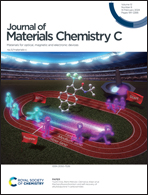Electrochromic electrically conductive Cu3(HHTP)2 films with adaptation to diverse and low-concentration water†
Abstract
Sea water, the most abundant water resource on the Earth, is rich in Na+, K+, Mg2+, and Ca2+ and possesses excellent conductivity, making it a highly promising and renewable source of electrolyte. However, the confined and narrow crystal spacing of traditional electrochromic materials limits the diffusion of largely hydrated ions in diverse ion electrolytes. Metal–organic frameworks (MOFs) with large intrinsic nano to microporous structures can serve as a promising host for the fast transport of hydrated ions. In this study, triphenylene-based electrically conductive MOF films were prepared and they underwent a reversible blue-to-yellow electrochromic process in diverse aqueous solutions (NaCl, KCl, MgCl2 and CaCl2). Due to the film's heightened sensitivity and wide-ranging compatibility, the ultra-low concentration electrochromic behavior at 0.1 mM can be maintained in sodium chloride solution. The MOF films show 16.9% optical modulation range and 1.5 s/2.0 s coloration/bleaching time in seawater. As a result, sea water, tap water and distilled water can be evidently distinguished by film color. This study not only demonstrates the potential application of the material as a visual ion concentration detector using low-concentration water and tap water in daily life, but also holds promise for applications in the realm of smart windows.



 Please wait while we load your content...
Please wait while we load your content...